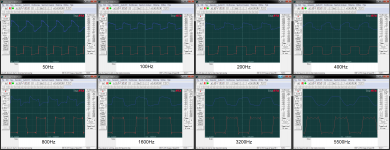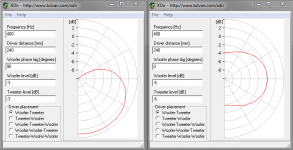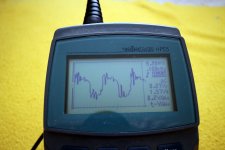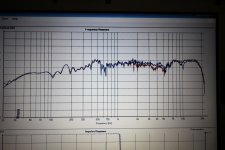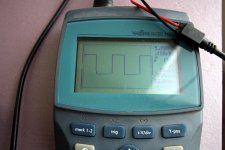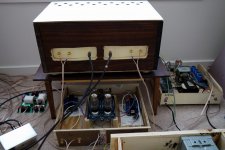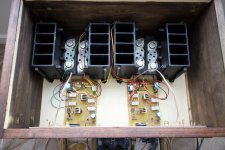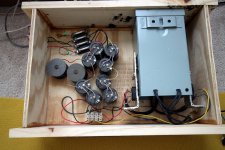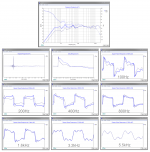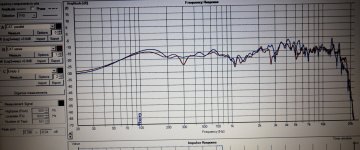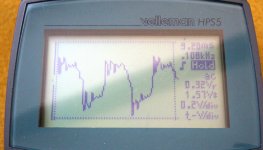I am having fun, nothing wrong with it.
I do have about half a dozen of analog crossovers, and even mini dsp and behringer, when it comes to digital.
I do have about half a dozen of analog crossovers, and even mini dsp and behringer, when it comes to digital.
My two main systems are bi amplified, so is ht.
That is not going to stop me learning by experimentation.
Jamehillj, have you measured square wave response of your speakers? Can you post the results?
That is not going to stop me learning by experimentation.
Jamehillj, have you measured square wave response of your speakers? Can you post the results?
Hi all, i did simple experiment, simple 2way, exactly the same cap and coil used, once series, once parallel. I measured fr response and then fed it square wave.
Fr response close between both crossovers, but not identical.
Square wave so bad in both cases, no need to mention it. Small difference too, but nothing like theory says.
Thanks feedback can imagine in real world its hard to get right with two components, from example post 30 one capacitor and inductor alone if driver impedance was flat would make all four plot example be textbook but real drivers resonance and inductance makes a lot of diference, then come baffle step and diffraction problems plus drivers ctc distance and acoustic center needed in sync.
Looked at my HDD here picture-1 some live square waves from past when exercising 1st order filters, think at that time it was 2x Behringer DEQ2496 that did XO/timing/Eq. That was a 10inch woofer and TC9FD, today in same exercise setup have a 10F mid-tweeter and LR8 XO at nearly same XO point, distortion profile is then better and with a more modern DSP can neutralize phase turn caused by steep LR8 so it produce square waves and IR/SR as in picture 2 plus 3. A thing that make me leave 1st order was vertical lobe that is some tilted when XO is not in phase at XO point seen in picture-4 with free XDir available from Tolvan Data who also share free The Edge program.
Attachments
Last edited:
... plus amplifier inequalities...
I believe my amplifiers are good enough 🙂
I used spare JLH high power class A amp...
with the power supply of 20 lbs trafo you can weld with, with 8x27000uF filter and a choke 🙂
Attachments
adason,
If that is Aurum Cantus AC130F1 pictured think is very clever driver to choose for 1st order exercises, have seen xrk971 share some measurements for AC130F1 that show very smooth wide bandwidth.
If that is Aurum Cantus AC130F1 pictured think is very clever driver to choose for 1st order exercises, have seen xrk971 share some measurements for AC130F1 that show very smooth wide bandwidth.
Been naughty and traced your blue trace from Holm plot, hope have it right in guessed that Y axis is 5dB steps. Into XSim system stop band BW2 roll offs was set to 42Hz and 20kHz and then gives grey traces in below, then added kind of baffle step correction a low shelve at 300Hz +6dB which is blue traces. Think if you don't get some close to these graphs that difference is acoustic center mismatch that would be easy to correct in a trial with use of your miniDSP or Behringer unit.
Attachments
That's neat BYRTT, and promising. What software is it you are using? Is it freeware?
I still do not know the direction where this little 2way is heading. Looks like it does not matter if it is series or parallel. I will put small l-pad to flatten the high frequencies, and will likely use it with hidden subwoofer, just to amaze visitors. That ac130f1 goes pretty deep on its own, but with sub it will shine.
Thanks!
Btw, i have one channel series, one parallel crossover, and it works fine as stereo. I can switch chanels without much notice.
I still do not know the direction where this little 2way is heading. Looks like it does not matter if it is series or parallel. I will put small l-pad to flatten the high frequencies, and will likely use it with hidden subwoofer, just to amaze visitors. That ac130f1 goes pretty deep on its own, but with sub it will shine.
Thanks!
Btw, i have one channel series, one parallel crossover, and it works fine as stereo. I can switch chanels without much notice.
I haven't got to the stage of feeding the speakers sq waves yet - still fighting with both the mids chamber and the bass box - having them measured at our Melbourne speaker manufacturers - playing with the Wild Burro drivers at present from 150Hz upwards (frame stiffening, rear magnet cowl, partially EnABL, tapered resistance chamber, etc)
I'm using the "Ultra Pro" (Berhinger) to set filter profiles and working on electronic 12dB high pass filter and a borrowed Mini-dsp for the bass filtering/adjustments - neither is very satisfactory for signal quality unfortunately, and investigating a few other dsp options - rather slow progress.
The intention is to go to multiple/distributed bass when new bass drivers are finished and use the Bodzio dsp Xover Program, maybe using a suitable processor (maybe even a Rasberry Pi!) - usb still looking easiest and quite promising
We have a rather expensive dsp out here called DEQX but even the cheapest version is over A$4500! - and it's also very easy to 'screw up' the sound at home, or in the studio too - happens all the time, unfortunately.
I did do a sq. wave test of an extremely well built 150Hz passive (did the Thiele designed chokes myself, at great trouble/effort!) and still showed a pretty ordinary picture on the CRO - sounds quite okay surprisingly!
Improving the room acoustics is my main focus these days - where the biggest upgrades are happening including the best of Jim Smith's advice ("Get Better Sound" - Jim Smith, USA)
I borrowed one of those Levinson multiple tone control preamps awhile ago - been looking for a way to recreate this via dsp ever since - I thought the "Ground Sound" would do it but, alas, 'no go' there either.
I do "love my tone controls" (it's a studio thing' but not a very 'audiophile' attitude, I gather!
I'm using the "Ultra Pro" (Berhinger) to set filter profiles and working on electronic 12dB high pass filter and a borrowed Mini-dsp for the bass filtering/adjustments - neither is very satisfactory for signal quality unfortunately, and investigating a few other dsp options - rather slow progress.
The intention is to go to multiple/distributed bass when new bass drivers are finished and use the Bodzio dsp Xover Program, maybe using a suitable processor (maybe even a Rasberry Pi!) - usb still looking easiest and quite promising
We have a rather expensive dsp out here called DEQX but even the cheapest version is over A$4500! - and it's also very easy to 'screw up' the sound at home, or in the studio too - happens all the time, unfortunately.
I did do a sq. wave test of an extremely well built 150Hz passive (did the Thiele designed chokes myself, at great trouble/effort!) and still showed a pretty ordinary picture on the CRO - sounds quite okay surprisingly!
Improving the room acoustics is my main focus these days - where the biggest upgrades are happening including the best of Jim Smith's advice ("Get Better Sound" - Jim Smith, USA)
I borrowed one of those Levinson multiple tone control preamps awhile ago - been looking for a way to recreate this via dsp ever since - I thought the "Ground Sound" would do it but, alas, 'no go' there either.
I do "love my tone controls" (it's a studio thing' but not a very 'audiophile' attitude, I gather!
adason,
: ) sounds as a nice 2-way plan having a square wave performer to surprise visitors and it should be possible on axis because ac130f1 combined a tweeter cover so much bandwidth so bigger delays in phase will only happen down where ac130f1 XO with sub.
All is nice freeware:
Graph tracer FPGraphTracer : fprawn labs
XSim: http://www.diyaudio.com/forums/multi-way/259865-xsim-free-crossover-designer.html
REW: REW - Room EQ Wizard Room Acoustics Software
Rephase: https://sourceforge.net/projects/rephase/
Graph tracer output frd-files that can either be imported to REW or link it to a driver inside XSim. To best read only the blue trace in your Holm plot i make a copy edited in MS paint where nearby traces from red trace is removed with eraser tool so graph tracer 100% pick the right trace. You don't get the phase this way that belong to that particular frq response but XSim can help double click on driver and tick "derived" where i set that stop bands mentioned as BW2 42Hz and 20kHz. If you happen be able to feed tweeter and mid-woofer drivers into XSim both a frd-file with in situation measured frq response and zma-file with impedance data for in situation cabinets, you will be able tweak capasitors/inductors/resistors and gets nearly exactly same result as plots says when you measure system later, if phase in measurements we base simulation is close to truth.
Low shelve 300Hz +6dB i did in REW by import frd-file then use their EQ prediction tool and read the new frq response from that plot with graph tracer and then linked that frd-file to one more new driver inside XSim.
List Rephase above not because of FIR filters but because of easy creation of IRR filters. In its IRR tab it takes a minute to create a known textbook target-curve for use imported in live measurements to hit right planned slope. Rephase outputs IR-wav files than REW can read, then if a frd-file is needed instead of, REW can export as frd-file.
Sense project is go simple passive and to not waste too much of your time and any components if system fail expectations have some pre stage suggestion. If i get frq/phase measurement without filters on tweeter alone + mid-woofer alone + both of them summed, all with microphone at same point in space at design axis. Then into XSim i should be able to calculate distance that tweeter will need corrected on a stepped baffle because we don't have digital delay in this passive scenario. With that number you can consider if that is acceptable mod to put into baffle, that fortunate looks as a foam core one that should be some way easy to mod. Also if its possible measure drivers impedance in box will support prediction how good simple XO will perform. A DATS device can do impedance plot and also REW and ARTA support via sound card measurement to create a zma-file.
: ) sounds as a nice 2-way plan having a square wave performer to surprise visitors and it should be possible on axis because ac130f1 combined a tweeter cover so much bandwidth so bigger delays in phase will only happen down where ac130f1 XO with sub.
All is nice freeware:
Graph tracer FPGraphTracer : fprawn labs
XSim: http://www.diyaudio.com/forums/multi-way/259865-xsim-free-crossover-designer.html
REW: REW - Room EQ Wizard Room Acoustics Software
Rephase: https://sourceforge.net/projects/rephase/
Graph tracer output frd-files that can either be imported to REW or link it to a driver inside XSim. To best read only the blue trace in your Holm plot i make a copy edited in MS paint where nearby traces from red trace is removed with eraser tool so graph tracer 100% pick the right trace. You don't get the phase this way that belong to that particular frq response but XSim can help double click on driver and tick "derived" where i set that stop bands mentioned as BW2 42Hz and 20kHz. If you happen be able to feed tweeter and mid-woofer drivers into XSim both a frd-file with in situation measured frq response and zma-file with impedance data for in situation cabinets, you will be able tweak capasitors/inductors/resistors and gets nearly exactly same result as plots says when you measure system later, if phase in measurements we base simulation is close to truth.
Low shelve 300Hz +6dB i did in REW by import frd-file then use their EQ prediction tool and read the new frq response from that plot with graph tracer and then linked that frd-file to one more new driver inside XSim.
List Rephase above not because of FIR filters but because of easy creation of IRR filters. In its IRR tab it takes a minute to create a known textbook target-curve for use imported in live measurements to hit right planned slope. Rephase outputs IR-wav files than REW can read, then if a frd-file is needed instead of, REW can export as frd-file.
Sense project is go simple passive and to not waste too much of your time and any components if system fail expectations have some pre stage suggestion. If i get frq/phase measurement without filters on tweeter alone + mid-woofer alone + both of them summed, all with microphone at same point in space at design axis. Then into XSim i should be able to calculate distance that tweeter will need corrected on a stepped baffle because we don't have digital delay in this passive scenario. With that number you can consider if that is acceptable mod to put into baffle, that fortunate looks as a foam core one that should be some way easy to mod. Also if its possible measure drivers impedance in box will support prediction how good simple XO will perform. A DATS device can do impedance plot and also REW and ARTA support via sound card measurement to create a zma-file.
Last edited:
thanks BYRTT, I will all check it out, sooner or later
its going to be busy work week, not sure when
its going to be busy work week, not sure when
No problem its your project take the time needed adason, that those measurements is welcome is mostly to see if offset is possible at all in reality, as example if it ends to be in 20-40mm area think its possible to step baffle but if its 100mm the step would probably be ugly and also ruin dispersion for tweeter completely.
Should you be curious to live listen midwoofer/tweeter build and also bench square waves in a 1st order config, you can temporary set it up with two of you nice amps and use Behringer or miniDSP as steereing. Those units can by turn a knob control all parameters delay/XO/baffle step/EQ so as amplitude slopes and timing gets right and show performance for build in 1st order config.
Should you be curious to live listen midwoofer/tweeter build and also bench square waves in a 1st order config, you can temporary set it up with two of you nice amps and use Behringer or miniDSP as steereing. Those units can by turn a knob control all parameters delay/XO/baffle step/EQ so as amplitude slopes and timing gets right and show performance for build in 1st order config.
Well, its raining outside, so no outdoors activity. I started this project to learn about series vs parallel crossover. I am working on AC130F1 and Dayton 3/4" tweeter 2-way to put it into bigger better box, in order not to roll off low frequencies in my temporary small open back enclosure. I think uneven fr response is messing up the square wave.
While I am working ot the box (Ikea bookshelf) I rewired one side of my open baffle 12CXT B&C coaxial. So the same story, one channel is parallel, one is series, the same speakers, the same crossover parts. Here is what I got.
While I am working ot the box (Ikea bookshelf) I rewired one side of my open baffle 12CXT B&C coaxial. So the same story, one channel is parallel, one is series, the same speakers, the same crossover parts. Here is what I got.
Last edited:
- Status
- Not open for further replies.
- Home
- Loudspeakers
- Multi-Way
- L-pad in series crossover

